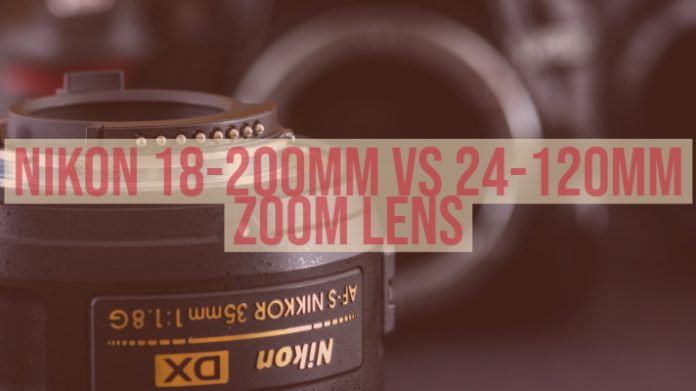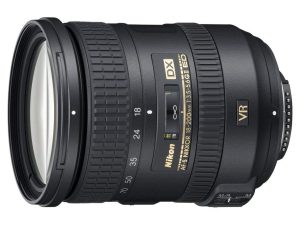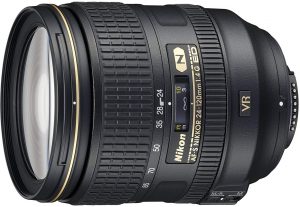Nikon has been actively involved in manufacturing outstanding lenses for most of your requirements. Of course, the Nikon lenses can also be used on other DSLRs provided they come with the support for the mount. However, if you are confused between the two most widely used Nikon lenses, here is a comparison for the best option among the two favorite lenses from Nikon. We will compare the Nikon 18-200mm vs 24-120mm lenses and check out how do they differentiate between themselves.
Nikon 18-200mm f/3.5-5.6G ED VR II – An Overview
In case you are looking for the best lenses for a wide range of shooting options, the NIKKOR 18-200mm f/3.5-5.6G ED VR II should be an optimum choice for most of your needs. The glass is robust in terms of best zoom features with an 11X zoom capabilities.
The lens offers a broader option right from 18mm wide-angle performance to a 200 mm telephoto option. This will make it a formidable choice for group shots and vast landscapes, while the telephoto compatibility will make it a good option for excellent portraits and action sequences — the VR or Vibration Reduction technique which is proprietary for Nikon that ensures an enhanced image clarity. The performance will also make it a good option for those conditions where proper lighting can be a big challenge.
Some features worthy of mentioning will include
- The 11X zoom compatibility makes it an excellent choice for an all in one lens for any of your shooting needs for a DX format DSLRs. The lens is capable of wide-angle cityscapes to action close-ups.
- Quality of images is yet another area that you will find quite exceptional with the Nikon 18-200 mm lens.
- The 3.5 stops image stabilization lets you shoot sharper images and high clarity HD video capture.
- The extra low dispersion glass elements ensure a maximized optical performance and aids you in reducing the chromatic aberration to a considerably greater extent.
Nikon 24-120mm f/4G ED VR – An Introduction
The f/4 standard zoom lens is an expert when you are looking for the admirable image quality at any value of aperture and focal length. The slim design and compact form factor make it a portable option. You have access to a 5X standard to a telephoto zoom lens functionality. The built-in Vibration Reduction and the Nikon’s advanced lens technology are the two features that will take you places. If you are an FX-format user, the lens should be the best you can go with.
The perfect compact design standard zoom lens can handle a wide range of shooting requirements. You can shoot any scenarios right from landscapes, portraits, weddings to distant subjects. It also offers you a constant maximum aperture for managing the actual exposure settings. The image stabilization through VR II lets you shoot the world-class images without having to worry about the shaking hands.
What are the salient features that will make it a formidable choice for your needs? Here are our picks for the best that Nikon 24-120 lens offers –
- The lens comes with a host of Nikon’s advanced lens technologies. Noteworthy among them can be VR II image stabilization, proprietary Silent wave motor, and Nano crystal coating.
- The Nano crystal coating is anti-reflective and eliminates the internal lens element reflections. The technology is supported across a wide range of wavelengths.
- The Extra-low dispersion or ED lens optical glass offers the maximum correction for the chromatic aberration.
How do the two lenses (Nikon 18-200mm vs 24-120mm) Compare with each other?
We thought of providing you a tabulated side by side comparison of the two competing lenses instead of a descriptive model of comparison. We believe that the side by side comparison can be helpful in comparing the best features and help you choose the one that best meets your requirements.
| Features / Particulars | Nikon 18-200mm [amazon_link asins=’B002JCSV8A’ template=’PriceLink’ store=’foi04-20′ marketplace=’US’ link_id=’5c7a73d1-1349-11e9-bc26-87b31b90a984′] | Nikon 24-120mm [amazon_link asins=’B003ZSHNEK’ template=’PriceLink’ store=’foi04-20′ marketplace=’US’ link_id=’384a6ef8-1359-11e9-970e-7dd33d1c0bc8′] |
| Lens Mount Type | Nikon F | Nikon F |
| Focal length | 18 to 200 mm | 24 to 120 mm |
| Maximum Aperture | f/3.5 to 5.6 | f/4 |
| Minimum Aperture | f/22 | f/22 |
| Format compatibility | Nikon DX | Nikon FX |
| Angle of view | 76 degrees to 8 degrees | 84 degrees to 20 degrees |
| Magnification | 0.22x | 0.24x |
| Lens construction | 16 elements in 12 groups | 17 elements in 13 groups |
| Diaphragm blades | Seven rounded blades | Nine rounded blades |
| Filter thread | 72 mm | 77 mm |
| Physical dimensions | 3.03 x 3.80″ / 77 x 96.5 mm | 3.31 x 4.06″ / 84 x 103 mm |
| Weight | 560 grams | 710 grams |
| Maximum Focal length | 200 mm | 120mm |
| Metal Mount | Yes, available | Yes, available |
| Reversible lens hood | Yes, available | No |
| Optical Zoom | 11x | 5x |
| Minimum focus distance | 0.5 m | 0.45 m |
Which One Should You Go with?
Well, that should be something that should be dependent on what you are looking for as a photographer. Both of them come with almost all similar features and options to aid you as a photographer.
The Nikon 24-120 mm lens, however, offers you a few features that make it a better choice compared to the Nikon 18-200 mm. Some of these features can be summed up as
- A wider aperture at the maximum focal length
- A reversible lens hood
- A shorter minimum focus distance.
- A wider maximum angle of view
Not that the latter is not a good option. The full range of zoom capability makes it an excellent choice. Ultimately, it should be dependent upon what you are looking for your photographic journey.
The Concluding Thoughts
That was a complete comparison between the two most capable lenses from Nikon. We assume we have covered almost all important aspects of both the lenses based on what photography enthusiasts would be looking ahead for. The side by side comparison chart should go a long way in aiding you to arrive at the right kind of decision when choosing your favorite lenses.
Have you used either of the two lenses among the Nikon 18-200 mm and Nikon 24-120 mm options for your photography expressions? If you have, we will welcome you to share your thoughts and experiences with us for arriving at the best comparison based on user experiences.



